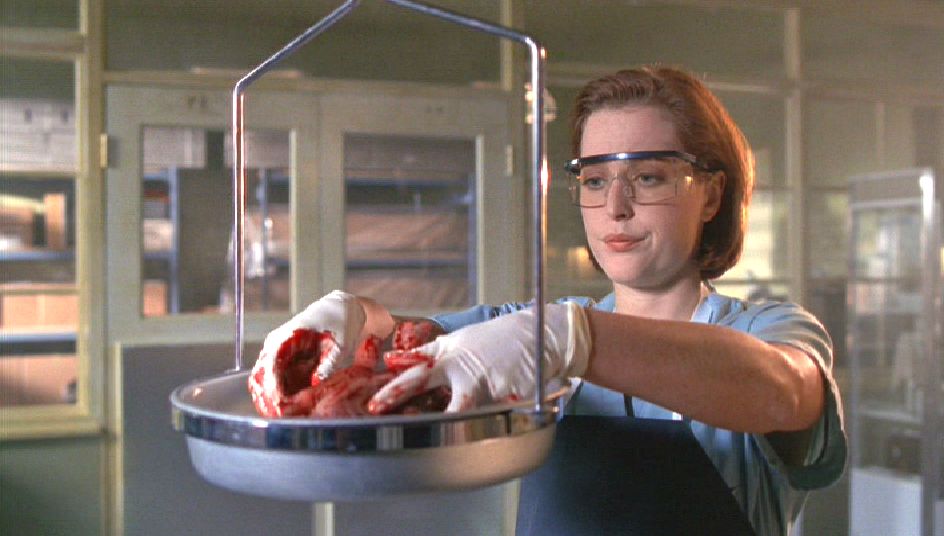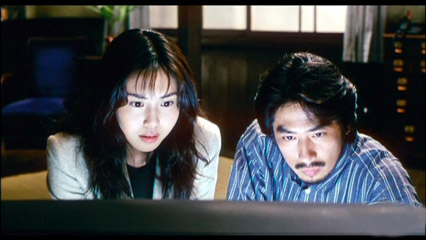This guest post written by Becky Kukla appears as part of our theme week on Women Scientists.
Dana Scully (Gillian Anderson) is my ultimate icon. She’s intelligent, cool-headed, and super sassy. She also has the best job in the world which usually involves traipsing miserably after her alien-obsessed FBI partner Fox Mulder (David Duchovny) in a bid to prove the existence of extraterrestrials to the United States government. Yeah… and I thought my job sounded stressful…
The X Files was, and to some extent still is, a cultural phenomenon. Countless articles and academic papers (including part of my dissertation) have been written about the cult aspect of the show, the allegories to our real world society, and the inversion of masculine/feminine stereotypes within the main characters (Mulder is an emotional believer, Scully is a rational skeptic). The X-Files often does hold a mirror up to the things we often glaze over within society, and its portrayal of The Syndicate (a group who effectively control everything in the world) as a bunch of old, white men is particularly relevant, even twenty years later. While The X-Files was busy being experimental in its monsters of the week and its representation of our society, the show tended to be incredibly formulaic in terms of the dynamic between the two main characters. No, I am not talking about that insatiable chemistry that still has us all guessing today, but the typical narrative structure of each episode. Mulder discovers a weird case with potential supernatural links, Scully tells him that he is mad and looks for scientific explanation, Mulder proves that his explanation is the correct one, all the evidence is destroyed (somehow) and Scully still finds that she can’t quite bring herself to ignore ‘the science.’
It makes for nostalgic viewing (we are never in any doubt about what will transpire throughout the episode), but it also feels like Scully gets the short straw a lot. Dana Scully is a qualified medical professional (“I’m a medical doctor!”), yet her years of training and experience fall flat against the little green men. She is exceptionally clever, but she is way out of her depth with these supernatural cases. Aside from doing autopsies, Mulder almost constantly has the upper hand throughout each case. That is until the events that transpire at the beginning of Season 2. Instead of investigating the science, Scully actually becomes the science.
At the beginning of Season 2, Scully is abducted — in both the physical and supernatural sense of the word — and it is later revealed that certain tests were performed on her. She returns safe and sound (okay, safe being a pretty optimistic word) and has no memory of these events, until about a season later. Scully realizes that a metal chip has been placed in the back of her neck (which she determines must have been placed there at the time of her abduction) and she ends up meeting with a group of women who have all had chips removed. Subsequently, all of the women she meets have succumbed to some sort of cancer. A skeptic at best, Scully brushes away these fears until it is revealed in “Memento Mori” that Scully has cancer, and it’s pretty bad.
I wish I could tell you that Scully’s life gets better from here on, but after her survival from cancer, she goes on to discover that during her abduction, her ova were harvested and have since been used to produce bizarre alien clone children — one of whom she has the pleasure of meeting in “A Christmas Carol” and “Emily.” But Scully’s road is never easy, and naturally, Emily dies.
To sum it up, Scully has a pretty terrible time and there seems to be a substantial link between Scully’s gender and the tests and science that is inflicted upon her. Is this her punishment for daring to be a woman in a male-dominated sphere? Scully is already “othered” by her presence in a patriarchal world as a woman — she frequently experiences sexist comments from other characters, exemplified by another female colleague in Soft Light. Scully becomes synonymous with the supernatural elements which Mulder is so fixated on, her female physicality means that she is the perfect candidate. Her ova were removed, cells which men do not possess, so it’s not a leap to say that Scully was abducted because she was a woman.
We are probably all aware of the existing link between ‘the mother,’ ‘the feminine’ and ‘the monstrous’ in science fiction (thanks Barbara Creed!). Motherhood and the reproductive process is fixated upon time and time again in the sci-fi world. Scully becomes removed from the supposed ‘natural’ process of motherhood, and her own body is used to breed alien hybrid children against her will or consent. She becomes a part of the ‘monstrous,’ something unnatural and seemingly abhorrent. In the episode, “Humbug” — as discussed by Lisa Parks in Deny All Knowledge: Reading The X-Files — Scully shares a moment with Lenny: a man with a detachable conjoined twin who turns out to be ever so slightly bloodthirsty. Both Lenny and Scully are caught off guard and share an embarrassing look at each other when both of their dressing gowns come slightly loose. As Scully stares awkwardly at Lenny’s belly, Lenny stares equally at Scully’s breast. The implication here is that both Scully and Lenny are alike in their otherness — both regarded by society as ‘other.’ This also comes at a point within the series after Scully has had the alien implant inserted in her neck, however she is not aware of it. The process of using her ovum to produce alien-hybrid clones has also begun, not that she knows it. As cyborg feminist specialist Donna Haraway — definitely check out her book, A Cyborg Manifesto — suggested; women, cyborgs, similans and the like are all “odd boundary creatures” which constantly threaten the traditional narratives and push the limits of science. Scully, and the other monsters we meet in The X Files are certainly guilty of that.
Aligning Scully with ‘othered’ alien life, cyborgs, and other women in the series posits her in this sort of feminized space, against the patriarchal FBI. However, Scully’s work (especially her initial task which was to debunk Mulder’s theories on behalf of her superiors at the academy) serves the masculine and patriarchal government. Indeed, even when Scully isn’t debunking Mulder’s odd (but accurate) theories, she is more often than not running around after Mulder, writing down his ideas, acting as his support staff, etc. In fact, it takes Scully until season 5 to express her annoyance at not even having her own desk in their shared office.
Scully continues to be skeptical of the existence of extraterrestrials, or of conspiracy theories — choosing instead to buy into the science. Despite everything that has been aggressively done to her, Scully can’t quite bring herself to believe that the existence of extraterrestrials can be real, even though her own body harbors the technology. As Lisa Parks points out, Scully’s position as a scientist is quite precarious. The science in the show is channeled through the feminized form (aka Scully) and therefore open to critical analysis, more so than if it was a male scientist. Scully, while a firm skeptic of aliens, is almost always intrinsically linked to this (as described earlier), so her skepticism of the supernatural and her insistence to hold onto this female fallible science seems to equate to her inability to accept herself.
There’s also something pretty grim in Scully’s abduction/missing ovum storyline that feels very reminiscent of higher powers meddling and making decisions about women’s reproductive rights. Instead of making laws, the Syndicate have a very real effect on the abductees’ abilities to have children therefore taking the decision away from the individual completely. It’s interesting to note that when men are victims of alien (or government) abduction in The X-Files, it is never intrinsically linked to the fact that they are male. On a very non-supernatural level, Scully constantly has to fight in the male-dominated space which is the FBI, and her shift from rational career woman to someone who has had the choice to bear children forcibly taken away from her serves to remind us that Scully is not male, however much she tries to assert herself.
Scully, while incredibly influential to generations of young women going into STEM subjects, is a rather questionable character. Traditionally, science has positioned female bodies as passive objects for male scientific dissection. Despite Scully being a scientist, as a woman, her body is still constantly placed under great scrutiny — from the clone offspring, to her cancer, even her tattooing exploits in “Never Again.” Dana Scully is an absolutely fascinating character, but it often feels as if she is being studied during The X-Files, when perhaps she should be the one doing the studying?
See also at Bitch Flicks: Beverly Crusher (‘Star Trek: TNG’) and Dana Scully (‘The X-Files’): The Medical and the Maternal; The Female Scientists of ‘The X-Files’; Sexual Desire on ‘The X-Files’: An Open (Love) Letter to Scully
Recommended Reading: Scully, What Are You Wearing? The Problem of Feminism, Subversion, and Heteronormativity in The X-Files by Lacy Hodges (University of Florida, 2005).
Becky Kukla lives in London, works in documentary production/distribution to pay the bills and writes things about feminism, film and TV online in her spare time. You can find more of her work at her blog femphile or on Twitter @kuklamoo.









